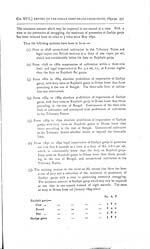Medicine - Drugs > Report of the Indian Hemp Drugs Commission, 1894-1895 > Volume I
(389) Page 354
Download files
Individual page:
Thumbnail gallery: Grid view | List view

354 REPORT OF THE INDIAN HEMP DRUGS COMMISSION, 1893-94. [CH. XVII.
These measures proved
ineffectual; and, although the consumption of Raj-
shahi ganja may have increased somewhat in all three districts of
Orissa, it was
believed that smuggling still continued to a considerable extent.
The
policy of total prohibition of cultivation naturally suggested
itself again,
and in 1884 was carried out in Mohurbhanj, which happened to be
under the direct
control of the Bengal Government. Rs. 300 a year was given to
Mohurbhanj as
compensation, and Rajshahi ganja was imported into the State under
the ordinary
Excise rules.
In June 1882 the
importation of Garhjat ganja and bhang into British terri-
tory was entirely prohibited, but it was not till 1884 that the
prohibition was actually
enforced. Further, from the same year (1882) the policy was adopted
of levying
duty in Orissa on Rajshahi ganja at rates lower than elsewhere in
the province.
Attempts were also made to entirely suppress cultivation in several
of the States
with the co-operation of the chiefs, and in 1889 the Superintendent
of the Tribu-
tary Mahals reported that prohibition had been enforced in eleven
of the States,
but that the chiefs of four other States objected to the
measure.
In 1889 the Bengal
Government finally concluded that the experiment of
entirely prohibiting cultivation must be abandoned as useless and
inefficacious,
and that the only way to prevent smuggling was to legalise
importation under
suitable regulations. Doubts were also entertained as to the real
nature of Garhjat
ganja. It was suggested that Garhjat ganja in a particular form was
looked upon as
an absolute necessary of life with certain influential classes in
Puri, and that injury
might be done by encouraging the use of the strong Rajshahi drug in
place of
the milder local article. The Government after some hesitation
arrived at the
distinct conclusion that Garhjat ganja was taken as a drink and not
smoked, and
that it was "on a different footing altogether from the well known
deleterious
drug imported from Rajshahi." It was accordingly proposed to
legalise the im-
portation of Garhjat ganja at a duty of eight annas a sér (the rate
prevailing in
Bengal for bhang), and at the same time the orders prohibiting
cultivation, whe-
ther within the three miles limit or not, were
withdrawn.
In 1890, after further
consideration and with fuller information on the subject,
the Bengal Government altered the opinion they had formed that
Garhjat ganja
was merely a form of bhang, and arrived at the contrary conclusion,
viz., that
Garhjat ganja is a true ganja like the Rajshahi article, but
inferior, and that it
is used for smoking exactly as that drug is. The Government of
India were
accordingly requested to sanction a duty of Rs. 2-8-0 a sér on
Garhjat ganja,
which was done.
In December 1890 the
orders prohibiting the possession of Garhjat ganja
in Orissa were rescinded, and in March 1892 orders regulating its
import were
issued.
From 1st April 1893 the
duty on Garhjat ganja was raised to Rs. 3-8 a sér
to assimilate it with a rise in the duty on Rajshahi
ganja.
Under existing rules, any
licensed wholesale or retail vendor may import.
Garhjat ganja under a pass from the Collector, for which a fee of
Rs. 2 is charged.
Set display mode to: Large image | Zoom image | Transcription
Images and transcriptions on this page, including medium image downloads, may be used under the Creative Commons Attribution 4.0 International Licence unless otherwise stated. ![]()
| India Papers > Medicine - Drugs > Report of the Indian Hemp Drugs Commission, 1894-1895 > Volume I > (389) Page 354 |
|---|
| Permanent URL | https://digital.nls.uk/74574844 |
|---|---|
| Description | Chapter XVII, cont. |
| Description | [Volume 1]: Report. |
|---|---|
| Attribution and copyright: |
|




